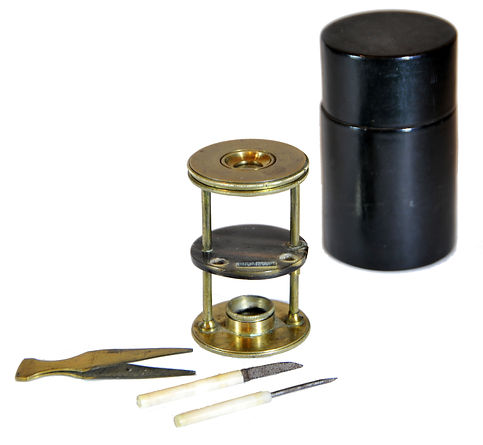

Withering-type botanical microscope, 1780
The “Withering-type Microscope” is named for its inventor, Dr. William Withering (1741-1799), an English physician and botanist who graduated with a degree in medicine 1766 in Edinburgh. Inspired by the taxonomical work and systematic classification of Carl Linnæus (1707-1778), Withering (1776) applied the Linnaean taxonomical system of classification to British plants in a seminal, two volume work, A Botanical arrangement of all the vegetables naturally growing in the British Isles. The earliest reference to a small botanical microscope of Withering’s design appeared in the first edition of this book. There, Withering indicated this microscope was developed for field dissections of flowers and other plant parts. While there is no surviving example of this exact design, close relatives of this type do exist, made either completely of brass or of ivory with brass pillars. Ivory models can be tentatively dated to 1776-1785, as by 1787 a newer model with a hollowed stage in an all-brass configuration already predominated. In turn, it was preceded by the brief appearance of a transitional brass model but with solid stage of ivory or horn (seen here). This version is extremely rare and must have been produced in very small numbers. By 1787 all these varieties were not recorded anymore in the literature.

Withering-type botanical microscope, 1780
The “Withering-type Microscope” is named for its inventor, Dr. William Withering (1741-1799), an English physician and botanist who graduated with a degree in medicine 1766 in Edinburgh. Inspired by the taxonomical work and systematic classification of Carl Linnæus (1707-1778), Withering (1776) applied the Linnaean taxonomical system of classification to British plants in a seminal, two volume work, A Botanical arrangement of all the vegetables naturally growing in the British Isles. The earliest reference to a small botanical microscope of Withering’s design appeared in the first edition of this book. There, Withering indicated this microscope was developed for field dissections of flowers and other plant parts. While there is no surviving example of this exact design, close relatives of this type do exist, made either completely of brass or of ivory with brass pillars. Ivory models can be tentatively dated to 1776-1785, as by 1787 a newer model with a hollowed stage in an all-brass configuration already predominated. In turn, it was preceded by the brief appearance of a transitional brass model but with solid stage of ivory or horn (seen here). This version is extremely rare and must have been produced in very small numbers. By 1787 all these varieties were not recorded anymore in the literature.
References: SML: A242712; Goren 2014.
References: SML: A242712; Goren 2014.
Prof. Yuval Goren's Collection of the History of the Microscope
Microscopes for Sale
From time to time, I may have some extra or duplicate items from my collection that I am willing to sell or exchange. However, please note that the collection displayed here is not currently available for sale. Unlike other online sales platforms, there are no unnecessary fees or overheads charged here, and the price is either predetermined or determined through fair negotiations.
Scroll down to see all
Case-Mounted Pocket Microscope, Early 19th century
This is an early 19th-century pocket microscope of a relatively rare design. It is reminiscent of the so-called Cary-Gould pocket microscope, which was said to be designed by Charles Gould under the directorship of William Cary in his workshop. In reality, versions of the theme of the pocket microscope, including duplicates signed by different makers who were probably only retailers, were on the English and Continental market during the first four or five decades of the 19th century.
EXCHANGED




Tourmaline Tongs, ca. 1860
These Tourmaline tongs are coming with a set of specimens of mineral crystal specimens mounted in square paper-covered cork plates (provably by Steeg & Reuter), as seen here.

SOLD


Tourmaline is classified as a semi-precious stone, and the gemstone can be found in various colors. Tourmaline crystals are highly birefringent, a crystallographic feature resulting in the split of a ray of light crossing the crystal outside its optical axis into an ordinary and an extraordinary beam, being polarized at right angles to each other. Tourmaline tongs are a primitive polariscope device having a transparent tourmaline crystal thin section in each half, mounted in cork in independently rotatable oxidized brass disks at the ends of a pair of spring tongs mounted with the transmission axes at right angles to each other. Specimens are slipped between the two tongs and observed by holding the system up to the eye. These specimens contain each a crystal slice set in a specific vibration axis of its optical indicatrix to yield an interference figure (seen in the photos taken with a cellphone camera through the instrument seen here). The device was invented by Jean-Baptiste Biot (1774-1862) as an inexpensive, effective, and easy-to-use polariscope. This early experimental work in physical optics, primarily concerned with studying the polarization of light and the birefringence of crystals, was the first step in creating the field of optical mineralogy.

